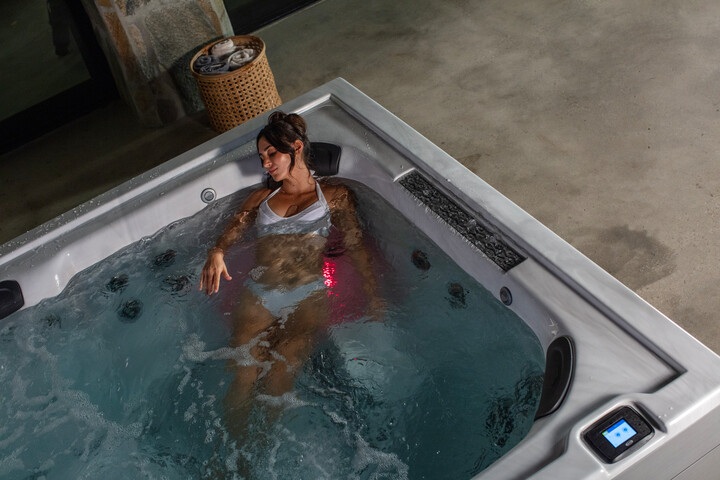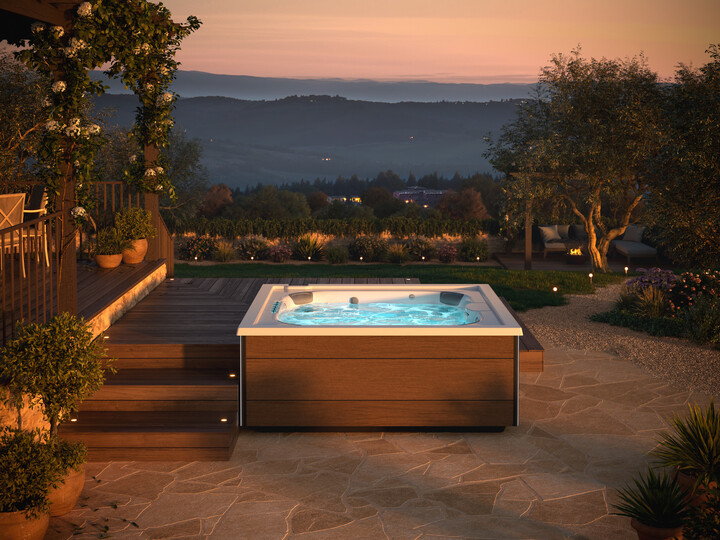Enjoy a refreshing, relaxing experience in your hot tub for years to come with these hot tub maintenance tips. Explore the steps required to clean your spa and how to get the most out of your backyard oasis.
Plan a DIY hot tub maintenance task or inspect your spa for signs of damage before contacting a professional repair team.
First-Time Hot Tub Maintenance Preparations
When you first purchase a spa, you may have lots of questions. Find the answers to your questions and the tips you need to prepare for the first time you use your spa. This guide and your owner’s manual offer you the information you need to maintain your favorite outdoor system.
Start by reading the owner’s manual that came with your hot tub. Review the particular features of your purchase to learn about programming cycles, setting the temperature and other specific tasks.
Once you’ve carefully reviewed the owner’s manual and added water to the spa, it’s time to set the temperature. A common temperature is about 102 degrees Fahrenheit, though you may want to set it under 100 degrees Fahrenheit if young children are using the spa.
Don’t attempt to use your hot tub without first adding chemicals to the water. This ensures that the unit is safe and that the water is safe for you. The amount and types of chemicals can vary, so be sure to test the water and follow any specific instructions for your hot tub before using additives.
When To Maintain Your Spa – Maintenance Schedule
Preventative maintenance is the ideal way to keep your hot tub clean, comfortable, and safe. From the first time you experience your backyard oasis, be sure to use the proper chemicals, cleaning steps, and maintenance schedule.
The best way to do this is to follow a basic hot tub maintenance schedule. It should look something like this:
- Daily tasks
- Weekly hot tub maintenance
- Quarterly hot tub maintenance
- Yearly hot tub maintenance
Explore these categories of tasks before diving into chemical use, quality cleaning products and signs of hot tub damage. While there are several schedules you need to track to be sure you’re up-to-date on your spa repairs, the tasks themselves are typically handled personally or with a quick call for hot tub repair in San Diego.
The timeline for hot tub maintenance tasks is a recommendation based on normal use. Even if you don’t use your spa frequently, you should still consider taking on these tasks in roughly the same timeline. Don’t wait months to check the temperature or years to clean the filter, or you may find excessive levels of contamination and a reduced lifetime for your outdoor oasis.
Daily Tasks
The daily steps to maintain your hot tub are, thankfully, the easiest on the list. All you need to do is inspect your hot tub cover, temperature and base.
The cover should be secure to trap heat and avoid water contamination. It’s also a safety measure if you have children in your home.
Any visible damage needs prompt repairs. While rare, this could happen due to extreme weather or animal issues.
Finally, the temperature should stay reasonably stable at the level you’ve set your spa. Any large temperature differences may be a sign that your hot tub needs maintenance. Always check the temperature before climbing into your spa, as a damaged thermostat or another component could create dangerous temperatures.
Weekly and Monthly Hot Tub Maintenance
At least once a week, you should test the water, rinse the filter, wipe off the cover and sanitize the water. Doing so keeps all that warm, sanitary water ready to enjoy, especially when you need it most!
Weekly hot tub maintenance includes a test of the following levels:
- Sanitizer
- Alkalinity
- pH levels
Use a recommended test product to receive accurate readings. You can find test strips and kits for sale that will accurately test the water, so you can see exactly which levels need to be adjusted. Verify the appropriate levels and, if necessary, adjust them with the right chemicals. Continue testing until the water has been properly balanced.
A weekly rinse of the filters promotes clean, debris-free water. Follow the manufacturer’s directions to remove the filter. Rinse it with warm or cool water, not hot. High temperature or pressure levels can damage the filter fibers and reduce its efficiency and lifetime.
Rinse it from multiple angles to remove debris and contaminants from the pleats. Wait until it’s fully dry before installing it in your hot tub. You can use a garden hose or tap water from your laundry basin, as the kitchen sink might not provide you with enough room.
If you are planning to use a garden hose, we suggest looking into an optional attachment called a filter flosser. Filter flossers distribute the water evenly and with the perfect amount of pressure suitable to clean a hot tub filter.
Your hot tub filter will require a deeper cleaning once a month. We suggest rinsing it first with water, then submersing it into a large bucket filled with filter cleaner that is diluted with water. Read the instructions for accurate measurements.
Let the filter soak for the recommended amount of time per the instructions, then rinse it and replace it in the spa. During this time, you will want to use a backup filter inside your hot tub to ensure that the spa water is filtered properly.
Quarterly Hot Tub Maintenance
Other necessary tasks are performed every few months.
One of the most important tasks is to drain and refill your spa. This process removes any dirt, debris and contaminants that aren’t removed with sanitizer and the spa filters. If your hot tub experiences significant use, you may wish to perform this hot tub maintenance task more frequently.
Start by flushing the lines. A line flush cleaning product should circulate for 20 minutes or more to clear any biofilm from the lines of your spa. Next, turn the power off and drain your hot tub. This is accomplished with a powerful drainage pump or a manual drainage feature. Be sure to remove all the water, using a wet-dry vacuum if necessary.
Proper water disposal depends on your location. In most situations, you’ll simply drain it into a sewer drain. All the added chemicals can harm plants, so don’t attempt to drain the water into your garden or yard. Use a recommended cleaning product to wipe down the spa shell and clean the filter. Choose a filter cleaning spray and a hot tub cleaner, or diluted bleach, to clean the various areas. Rinse the entire unit before refilling it.
Add water and the recommended level of spa chemicals before testing, circulating, and re-testing the water. Once the second test is passed and you wait 24 hours, it’s time to relax in your spa.
Yearly Hot Tub Maintenance
Perform these tasks infrequently, usually once a year. Add these tasks to your yearly schedule to reduce the risk of a spa issue:
- Inspect wiring and hardware
- Schedule a professional inspection
- Update your hot tub maintenance calendar
- Replace your hot tub filter
You don’t need to be an electrician to spot issues in the wiring or hardware. Don’t attempt to perform any electrical repairs on your own, but monitor the wiring and the performance of any electrical items on your hot tub.
Contact a local service team, like our team at Lifestyle Outdoor, for a thorough yearly inspection.
Chemical Safety and Proper Use
No one wants a spa full of bacteria, unusual smells or strong chemicals. Achieve the proper balance and safely add chemicals to your hot tub to enjoy a refreshing time. Here are some of the most common chemicals you should have stocked for weekly and quarterly hot tub maintenance tasks:
- Chlorine or bromine: Acts as a sanitizer to remove germs and bacteria.
- Shocking agent: Releases oxygen into the water to temporarily increase the chlorine level for a short period of time to sanitize it.
- Sequestering agent: Removes heavy metals and calcium from your spa to prevent green, orange, brown or red hues.
- pH increaser: Increase the pH level to avoid irritation and ineffective sanitizer.
- pH decreaser: Decreases the pH level to help achieve a neutral spa.
- Calcium: Balances calcium and magnesium levels to avoid a foamy or cloudy appearance.
- Defoamer: Cuts down on foamy water in your spa.
Your water needs treatment once it’s first filled, any time it’s refilled and when a test comes back with improper chemical balances. Always review your owner’s manual before applying a chemical for proper use. Consider wearing gloves to avoid contact with these additives.
Must-Have Cleaning Supplies
Cold or warm water works well to clean the filters in your spa, but the shell, cover and other areas need more powerful cleaning agents. Part of hot tub maintenance is a thorough cleaning routine, so ask your maintenance team about these supplies or pick them up for an essential cleaning kit:
- Hot tub plumbing: Add a specialized cleaner to the water before you drain it to flush out the pipes. This specialized cleaner removes biofilm.
- Cover: Spray your cover with a non-sudsing cleaner and wipe it with a cloth. This removes mildew from the underside and other debris from the top of the cover.
- Filters: If a thorough rinse doesn’t fully clean your filter, then it’s time for a new one.
- Shell: Use the same non-sudsing cleaner, or a dedicated cover cleaner, to wipe away any grime.
We do not recommend using household cleaning agents to maintain your spa. Options such as vinegar, baking soda and bleach can often do more harm than good when it comes to the quality and longevity of your spa. Always use products from your local hot tub store.
Disposable sponges, shop towels, buckets, a spray bottle, and rubber gloves are additional items to include in your personal hot tub cleaning kit. Visit a local spa store to find the quality chemicals and must-have cleaning supplies to take on these tasks yourself.
Signs of Hot Tub Damage
Years of use, missing hot tub maintenance tasks or improper use can all contribute to the overall health of your hot tub and possible reasons for repair. Look out for these signs that you need to repair or replace your spa.
Major temperature changes point to a damaged heater or thermostat. During your daily check of the water temperature, look for unusual fluctuations. Low or high temperatures can mean a short in the wiring, a damaged heating unit or a thermostat that isn’t reading correctly.
An error code on the control panel is another sign that you have electrical issues. Some spas have error codes for particular systems, while others show a more generic code. Either way, an error is sometimes caused by a pressure switch malfunction, damaged circulation pump or short in the wiring.
The jets in your hot tub should have consistent pressure. Low or irregular pressures can be caused by a clogged filter or calcium buildup. Rinse the filter and consider cleaning the plumbing lines. If these maintenance steps don’t work, you may need professional cleaning and repair.
Professional Hot Tub Maintenance
If you’re using your spa to recover from an injury or manage pain, or don’t want to spend your weekends draining water and scrubbing the shell, a professional maintenance service can offer the convenience you deserve.
Instead of handling chemicals and harsh cleaners, an expert hot tub maintenance and repair service provider in your area can easily take on routine tasks for your spa. Ask a local team to inspect your system and recommend a maintenance schedule.
A professional can come by once a week, quarterly or once a year to monitor and maintain your spa. Choose a talented team for around-the-year support and early warning signs of a major spa repair.
7 Benefits of Preventative Hot Tub Maintenance
A little washing, rinsing and adding chemicals can have a major impact on the lifetime of your spa and the quality of your experience. Here are some common benefits of professional or DIY preventative hot tub maintenance:
- Increased spa lifetime
- Improved water scent and color
- Improved mood while enjoying the spa
- Increased jet pressure
- Reduced risk of mold or mildew
- Reduced risk of cracks and leaks
- Reduced risk of skin problems
These issues are often caused by a lack of chemical additives, extended periods without cleaning or failure to spot major repair issues. Step into a warm, comfortable and safe spa by performing these steps or working with a local repair team.
Hot Tub Maintenance at Lifestyle Outdoor
Prepare for an unforgettable experience with Lifestyle Outdoor. If you’re ready to receive a quality spa and fill it up for the first time, it’s time to shop the best deals on hot tubs for sale in California.
Contact our expert team to ask about particular packages or unusual maintenance issues. Create a personalized outdoor oasis with our backyard hot tub inspiration. Explore hot tub maintenance FAQs and other answers with our additional resources.
You deserve a comfortable, long-lasting hot tub in California, so work with our team to elevate your calming outdoor experience.





